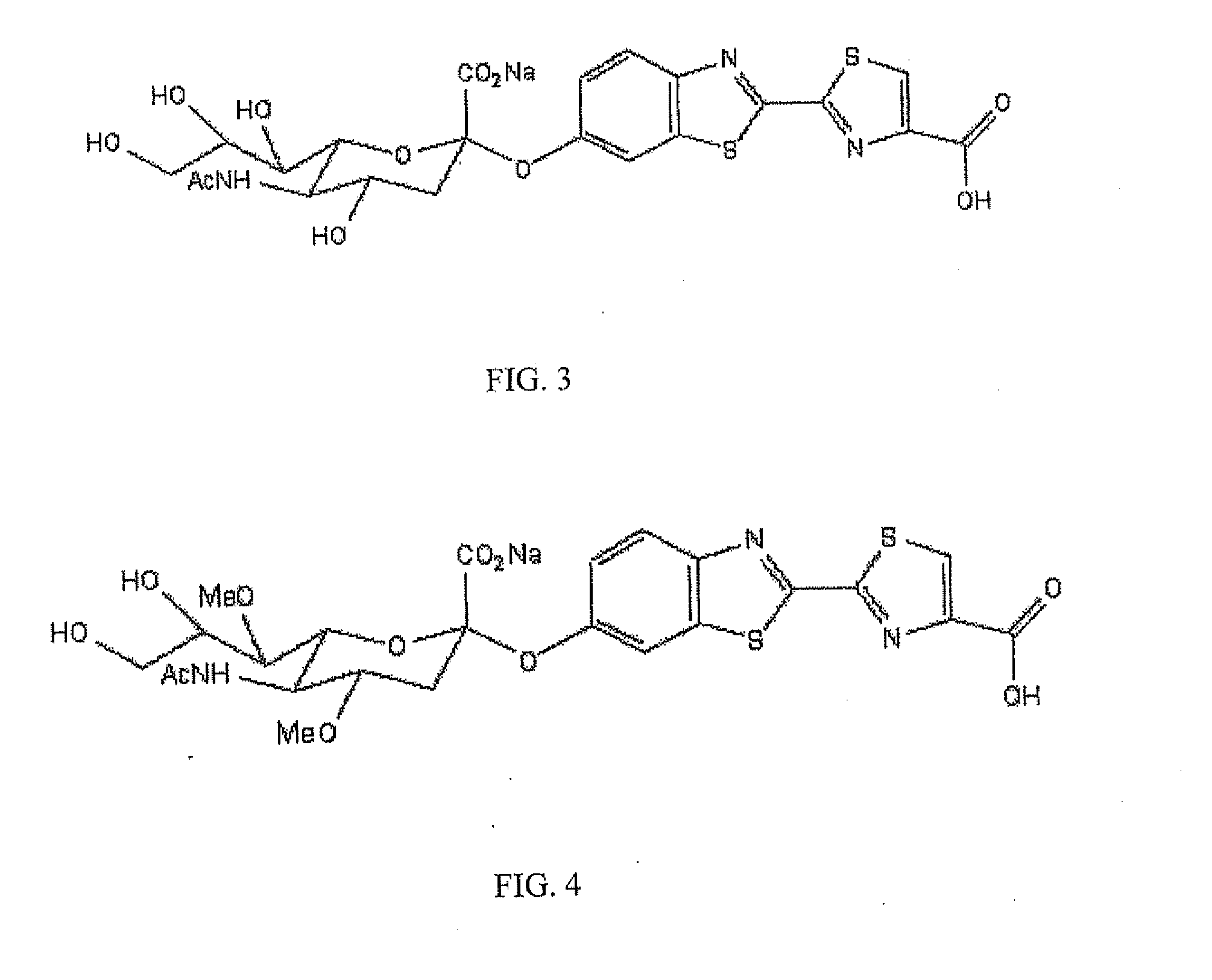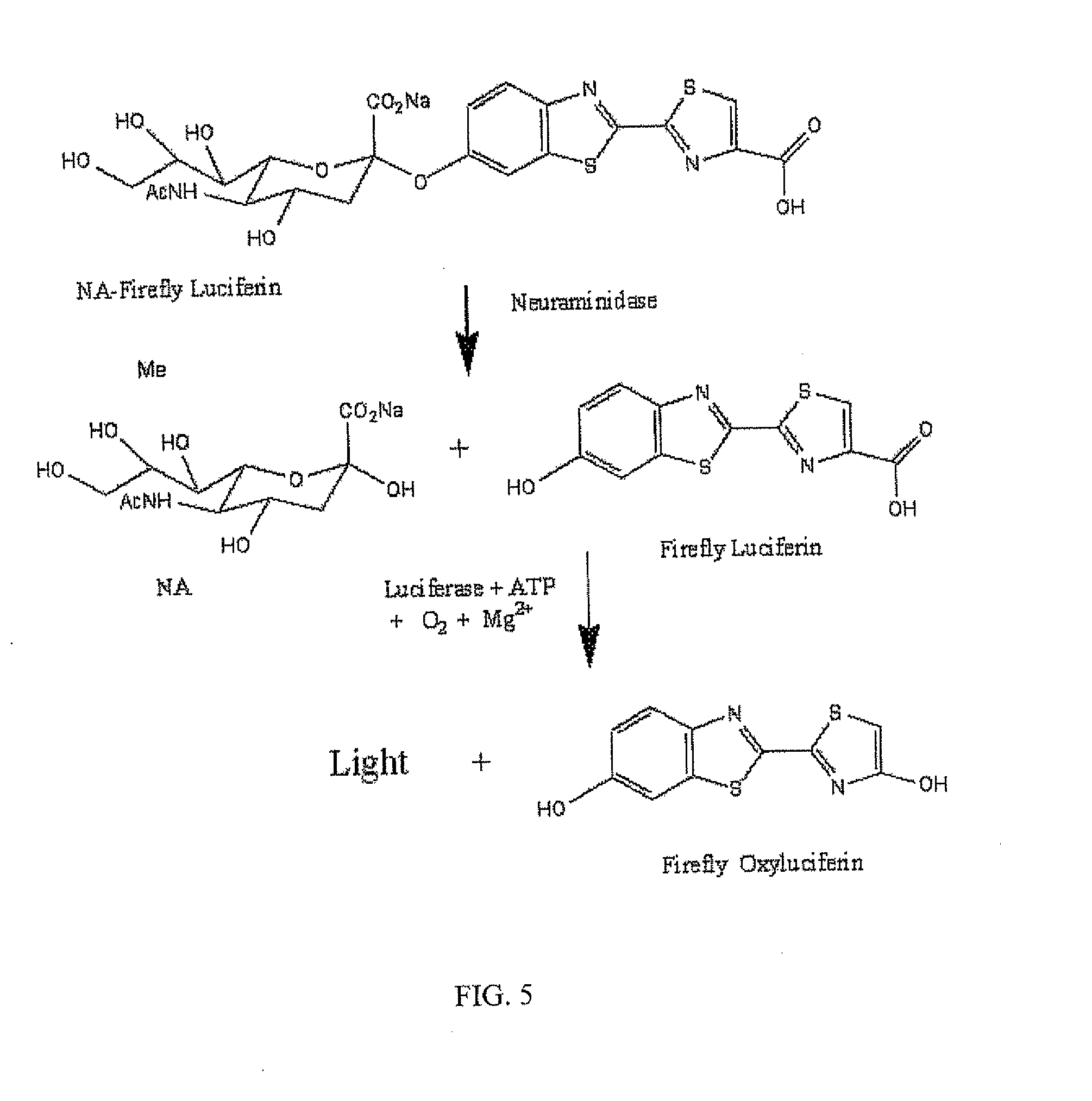Reagents and kits for detection of influenza virus and the like
a technology for influenza virus and reagents, applied in the field of influenza virus detection reagents and kits, can solve the problems of inability to detect influenza virus at the point of care, inconvenient use, and large number of deaths and economic impacts, and achieve the effects of simple, rapid, specific and sensitive detection
- Summary
- Abstract
- Description
- Claims
- Application Information
AI Technical Summary
Benefits of technology
Problems solved by technology
Method used
Image
Examples
example 1
Test Kit Formulation and Influenza Virus Detection
[0079]Synthesis of N-acetylneuraminic acid-Firefly Luciferin Conjugate
[0080]Methods for synthesizing the conjugate depicted in FIG. 3, or similar conjugates, can be derived from existing methods. For example, a method for synthesizing N-acetylneuraminic acid-dioxetane conjugate, described in a publication (e.g., Analytical Biochemistry 280, 291-300), can be used for synthesis of the conjugate depicted in FIG. 3, or similar conjugates. An example for the synthesis of the N-acetylneuraminic acid-firefly luciferin conjugate is described as follows: Methyl (5-acetamido-4,7,8,9-tetra-O-acetyl-3,5-dideoxy-D-glycero-b-D-alactononulopyranosyl chloride) Onate was prepared in two steps from a commercially available N-acetylneuraminic acid as described a publication (Analytical Biochemistry 280, 291-300), which is cited here solely for reference. The crude chloride was purified by a silica gel plug, and eluted with 200 mL of 80-90% EtOAc in hex...
example 2
Real Time Detection of Influenza Viral Neuraminidase Using the Neuraminic Acid-Firefly Luciferin Conjugate for the Detection of Influenza Virus
[0105]In this example, influenza viral neuraminidase activity is detected at real time, i.e., neuraminidase reaction and biochemiluminescence reaction are combined in a single reaction tube and carried out simultaneously. A master mix that contains all necessary components except for neuraminidase and free firefly luciferin was formulated according to the composition for the Detection Mix (see below). After adjusting the pH to 7.0 to 7.2 and the final volume, the mix is stored at 2-8° C. overnight, which allows the luciferase consume the contaminating free luciferin and thus reduces the background. The detection mix is then aliquoted into vials (1.0 mL each), lyophilized, and stored at −20° C.
[0106]For influenza virus detection, one vial of the lyophilized detection mix is suspended in 0.9 mL of buffer containing 1% Triton X 100 or NP-40 equi...
example 3
Use of Antibodies to Inhibit Non-Specific Neuraminidase Activity in an Influenza Viral Neuraminidase Assay
[0125]The commonly used clinical samples for influenza detection are throat and nasal swabs. Some bacterial species that are found in nasal or oral can also secret neuraminidase. These bacterial species include Streptococcus pneumoniae and Actinomyces viscosus. In this example, monoclonal or polyclonal antibodies specific for the neuraminidases for these bacterial species are added to the conjugate mix in Example 1 or the lysis buffer or detection mix in Example 2. Bacterial neuraminidase in the sample, if any, is blocked by the antibodies thereby reducing the background. The optimal amounts of antibodies need to be determined experimentally.
PUM
 Login to View More
Login to View More Abstract
Description
Claims
Application Information
 Login to View More
Login to View More - R&D
- Intellectual Property
- Life Sciences
- Materials
- Tech Scout
- Unparalleled Data Quality
- Higher Quality Content
- 60% Fewer Hallucinations
Browse by: Latest US Patents, China's latest patents, Technical Efficacy Thesaurus, Application Domain, Technology Topic, Popular Technical Reports.
© 2025 PatSnap. All rights reserved.Legal|Privacy policy|Modern Slavery Act Transparency Statement|Sitemap|About US| Contact US: help@patsnap.com



